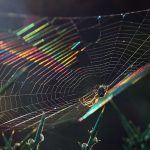By Gary Swick, FOFR President
Nature offers us much that we take for granted. Our need for drinkable water, clean air, and bounty of food choices are often underappreciated because they are so readily available. In addition, nature provides many beautiful gifts of art for our appreciation. Many of us are anticipating with excitement the fashion show that our deciduous trees will soon be providing. Recently, a particular work of art provided by a spider reminded me of our watershed’s many connections.
What is a Watershed?
I have found that very few folks really know what a watershed is. For Friends of the Fox River (FOFR), this is an important challenge. We are 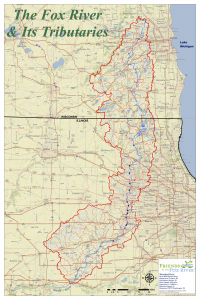 not only protecting a river but its whole watershed, which is quite large.
not only protecting a river but its whole watershed, which is quite large.
Let’s use the spider web as an analogy. The web has borders, created by the builder’s decision on attachment points, like a tree branch. A watershed’s boundaries are created mostly by topography and generally its water runs downhill. Webs resemble a geometric shape like a circle or a square; a watershed usually does not. The Fox River Watershed is long and narrow. A web has a central point to which vibrations in the strands travel. A watershed drains its entire land area to a body that can be a creek, river, lake, or ocean.
The important takeaway here is that what happens anywhere in either the web or watershed goes somewhere. In the case of the watershed, litter, or dog poop on a parkway can enter a storm drain and find its way to the river. In our case, ultimately to the Gulf of Mexico.
Managing a Watershed
It is common knowledge that many, maybe most, of our activities in the watershed have the potential to impact water quality. The construction site that exposed soil, lawn, roadside litter, deicing materials, yard waste, and toxic chemicals in residential areas is every bit as much as a threat to water quality as are agricultural run-off and urban waste water.
Thus, all one million plus residents of our watershed must be aware, understand, and care about their impacts if we are going to maintain a healthy resource that provides drinking water, wastewater disposal, and recreation – which are vital to our communities.
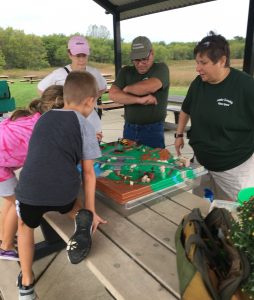 FOFR offers EnviroScape trainings in which educators use watershed models to demonstrate the concept (whatever happens anywhere in the watershed goes somewhere) to interested groups. Please contact us for more information about their availability.
FOFR offers EnviroScape trainings in which educators use watershed models to demonstrate the concept (whatever happens anywhere in the watershed goes somewhere) to interested groups. Please contact us for more information about their availability.
The Vision
The founder of FOFR, Pat Reese, had the vision to manage our watershed, not as separate parcels, but as a whole – a watershed approach. The concept is simple, but implementation is a huge challenge. The Fox River connects two states, 15 counties, 100 different governments, and 1.3 million people.
We are making progress, though, through collaborative efforts. Two years ago, FOFR organized a paddle wheel cruise in St. Charles to bring together passionate advocates from many organizations to share our individual and collective hopes and interests. The Fox River Summit is an annual gathering of professionals, organizations, and the public to address this task. From the Summit arose the Fabulous Fox Water Trail, a newly developed recreational trail developed in partnership with the National Park Service, both in Wisconsin and Illinois.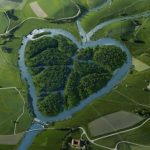
At this year’s Fox Summit, FOFR proposed an annual “It’s Our Fox River Day – A Watershed Wide Celebration.” We supported local organizers and coordinated the event, had good participation, and several communities adopted a proclamation to continue and grow this annual event. These are collaborative but mostly symbolic steps, but it is progress that should be heralded. We have come a long way from the murky and stinky river waters of the 1970’s.
Networking
Finding our common interests and working together is what is needed. Originally, FOFR was established in part to be a scientific authority. Through a series of governmental actions, the Fox River Study Group (FRSG) was formed as a diverse coalition of stakeholders working together to assess water quality in the Fox River watershed.
Study Group members include Friends of the Fox River, Sierra Club, Fox River Water Reclamation District (Elgin), Fox Metro Water Reclamation District (Aurora), Fox River Ecosystem Partnership, Illinois Environmental Protection Agency (IEPA) and Blackberry Creek Watershed Plan Implementation Council as well as representatives from Algonquin, Aurora, Batavia, Crystal Lake, Elgin, Geneva, Island Lake, Kane County, Lake in the Hills, St. Charles and Yorkville.
These stakeholders work collaboratively to improve the water quality of the Fox River (from the McHenry Dam to Yorkville) under a USEPA mandate to improve the health of the Mississippi River watershed, of which the Fox River watershed is a component.
Citizen’s Role
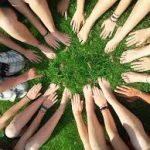 Another founding mission of FOFR is to empower citizens through education and participation. Many of you have attended or volunteered at our events in a chair at the Schweitzer Environmental Center, walking with a trash bag along the riverbank, or seated in a canoe. These are important actions to develop connections to the watershed.
Another founding mission of FOFR is to empower citizens through education and participation. Many of you have attended or volunteered at our events in a chair at the Schweitzer Environmental Center, walking with a trash bag along the riverbank, or seated in a canoe. These are important actions to develop connections to the watershed.
Some folks are unable to attend events and choose to support our efforts through financial contributions or provide services through our Business Partner Program. But we need more help to achieve our growing list of initiatives. Serving on one of our committees by bringing your skills, ideas, and energy is a much-needed solution to a void we seek to fill.
We are also interested in connecting young families to collaborate on local activities that make the river part of their culture, too. Our watershed is large, and our web of networking potential is too.
Look for the Spider’s Web
Autumn is the season of harvest, a time to gather our resources. The most important resource needed to protect the watershed is its residents. Now that you know what a watershed is, please consider how you can develop your friendship with the Fox River watershed through FOFR. I hope you also enjoy the many gifts that nature provides our senses. Look and listen to all the season offers: the dew glistening on a spider’s web, the color palate displayed on leaves, the sound of the wind, and the feeling of change.



